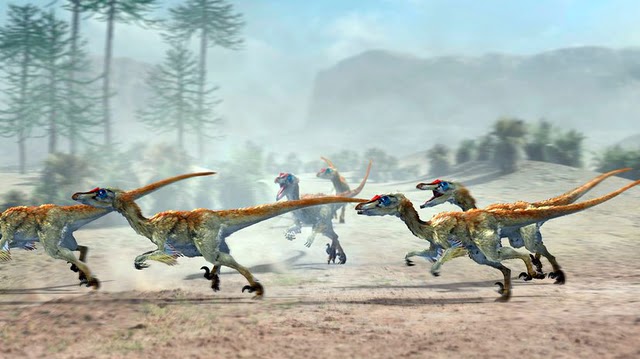Quck answer
Despite what popular culture may suggest, recent studies suggest that Velociraptors likely hunted solo, rather than in packs. While there is evidence to suggest that some dinosaurs did hunt in groups, such as the famous Tyrannosaurus Rex, the evidence for Velociraptors hunting in packs is not as strong. Researchers have found that Velociraptor fossils are often found alone, rather than in groups, and that their physical characteristics suggest that they were adapted for solo hunting. While there is still much to learn about these fascinating creatures, it appears that our understanding of their behavior is constantly evolving.
Extinct Animals

Despite their depiction in the “Jurassic Park” films, it seems that Velociraptors did not hunt in packs. The films show the raptors working together in a chain of command, attacking prey in a strategic and organized manner. However, the dinosaur known as Velociraptor in the films is actually based on a different animal called Deinonychus, which was much larger. Both animals had a specialized toe on each foot with sharp claws.
Mistaken Identity
The adult Deinonychus could measure up to 11 feet long and weigh over 200 pounds, while Velociraptor was about the size of a turkey. Both were bird-like carnivorous dinosaurs and members of the dromaeosaurids family. The bones of four Deinonychus were discovered in Montana in 1931 and named in 1969 by Yale paleontologist John Ostrom. Ostrom theorized that the four Deinonychus had been killed while attacking a much larger herbivore in a coordinated group effort, similar to a wolf pack.
A Wolf in Dinosaur’s Clothing
Ostrom’s theory influenced Michael Crichton, who wrote about pack-hunting dromaeosaurs in his novel “Jurassic Park”. This concept has become a popular idea, and it has been argued that other predatory dinosaurs may have hunted in packs as well. However, in a 2007 paper, paleontologists Brian Roach and Daniel Brinkman concluded that no non-avian predatory dinosaur would have formed packs. They defined “true cooperative pack hunting” as a group hunting effort carried out by animals that habitually work together to capture prey too large for an individual predator to kill alone. No living bird or reptile fits this criteria.
According to Roach and Brinkman, the Komodo dragon is the only living animal that could offer insight into the behavior of non-avian theropods, such as dromaeosaurs, around large prey. These reptiles are effective solo hunters capable of bringing down prey ten times their size, but they are also scavengers that mob a carcass when one of them kills a large prey item. During these feeding frenzies, the Komodos may attack and cannibalize each other. Brinkman and Roach suggest that non-avian theropods were also solitary hunters that engaged in cannibalistic feeding aggregations. While finding teeth and bones together is one thing, dinosaur footprints can shed more light on pack-hunting behavior. In 2007, a dromaeosaur trackway discovered in China indicates that these animals were traveling in some kind of group. However, more evidence is needed to confidently cite any footprint assemblage as the product of pack-hunting. Recent studies have found that the recurved toe claws of dromaeosaurs were better equipped for stabbing or puncturing rather than disemboweling prey, and they might have used these toes to help them cling onto large prey.
FAQ
1. What are velociraptors?
Velociraptors are extinct carnivorous dinosaurs that lived during the Late Cretaceous period, about 75 to 71 million years ago. They were small but agile predators that were known for their sharp teeth and claws.
2. How did velociraptors hunt?
Based on recent studies, velociraptors likely hunted solo and used their speed and agility to catch their prey. They may have also used their sharp claws to tear into their prey’s flesh.
3. Why are velociraptors often depicted as hunting in packs?
Velociraptors were famously depicted as hunting in packs in the Jurassic Park movie franchise. This was based on a theory proposed in the 1960s that suggested that some dinosaurs, including velociraptors, may have hunted in groups. However, recent research has challenged this theory.
4. What evidence supports the idea that velociraptors hunted solo?
Recent studies have analyzed the shape and structure of velociraptor bones, as well as their teeth and claws. These analyses suggest that velociraptors were likely solitary hunters, rather than pack hunters. Additionally, studies of modern-day bird behavior, which are descendants of dinosaurs, support the idea that some dinosaurs may have hunted alone.
5. How did velociraptors communicate with each other?
It is unclear how velociraptors communicated with each other, as they did not have vocal cords like modern-day birds. Some scientists have proposed that they may have communicated through visual cues, such as body language and color changes.
6. Did velociraptors have feathers?
Yes, recent fossil discoveries have shown that velociraptors had feathers. These feathers were likely used for insulation and display purposes, rather than for flight.
7. What did velociraptors eat?
Velociraptors were carnivorous and likely ate a variety of small animals, such as lizards, mammals, and other dinosaurs.
8. How fast could velociraptors run?
It is estimated that velociraptors could run at speeds of up to 40 miles per hour, making them one of the fastest dinosaurs.
9. How did velociraptors defend themselves?
Velociraptors had sharp claws and teeth that they could use to defend themselves. They may have also used their speed and agility to avoid predators.
10. What caused the extinction of velociraptors?
Like many other dinosaurs, velociraptors went extinct about 66 million years ago, likely as a result of a massive asteroid impact that caused widespread environmental devastation.
11. Have any living animals descended from velociraptors?
Yes, modern-day birds are descendants of dinosaurs, including velociraptors. However, birds have evolved significantly since the time of the dinosaurs and do not resemble velociraptors in appearance or behavior.
12. Are there any velociraptors alive today?
No, velociraptors went extinct millions of years ago and do not exist today.





Leave a Reply